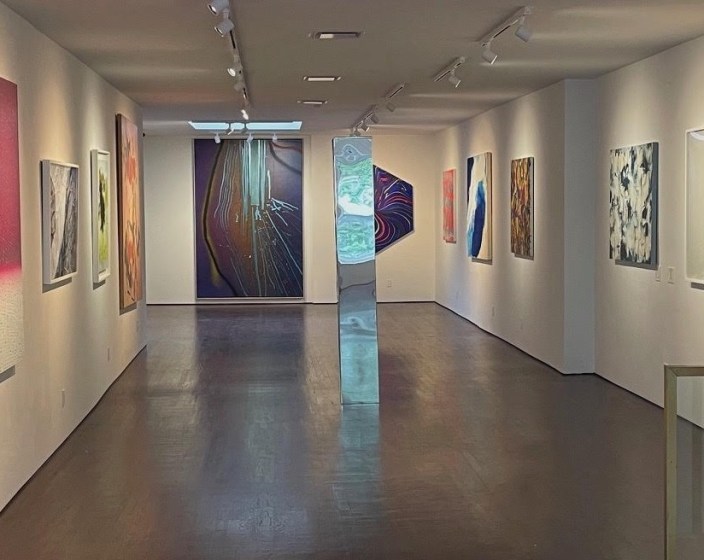
Two Hills #8, 2023
Acrylic on canvas
72 x 60 inches
Signed, titled, and dated on the verso
Two Hills #7, 2023
Acrylic on canvas
60 x 48 inches
Signed, titled, and dated on the verso
Two Hills #6, 2023
Acrylic on canvas
60 x 48 inches
Signed, titled, and dated on the verso
Two Hills #5, 2023
Acrylic on canvas
60 x 48 inches
Signed, titled, and dated on the verso
Two Hills #4, 2023
Acrylic on canvas
46 x 36 inches
Signed, titled, and dated on the verso
Two Hills #2, 2023
Acrylic on canvas
46 x 36 inches
Two Hills #1, 2023
Acrylic on canvas
46 x 36 inches
Signed, titled, and dated on the verso
Red Hill, 2023
Acrylic on canvas
60 x 48 inches
Signed, titled, and dated on the verso
Pink Panther, 2024
Acrylic on canvas
72 x 60 inches
One Hill #2, 2024
Acrylic on canvas
60 x 48 inches
Signed, titled, and dated on the verso
One Hill #1, 2023
Acrylic on canvas
60 x 48 inches
Signed, titled, and dated on the verso
Hidden Hill, 2010
Acrylic on canvas
60 x 60 inches
Signed, titled, and dated on the verso
Cypress Hill, 2017
Acrylic on canvas
14 1/4 x 11 1/4 inches
Signed, titled, and dated on the verso
Arch Horizon Double Hill #6, 2017
Acrylic on canvas
14 1/4 x 11 1/4 inches
Signed, titled, and dated on the verso
Untitled # 681, 2014
Acrylic on board
42 x 42 inches
Signed, titled, and dated on the verso
Arch Horizon-Hill and Bumpy Dale, 2018
Acrylic on canvas over board
45 x 36 inches
Signed, titled, and dated on the verso
Untitled #661, 2013
Acrylic enamel and 23 karat gold on board
42 x 42 inches
Signed, titled, and dated on the verso
Untitled #674, 2015
Acrylic on canvas over board
72 x 60 inches
Signed, titled, and dated on the verso
Dish and Cross, Greenpoint, 2011
Acrylic on canvas over board
36 x 36 inches
Signed, titled, and dated on the verso
Untitled #673, 2014
Acrylic on canvas
42 x 36 inches
Signed, dated, and titled on the verso
Untitled, #64, 2012
Acrylic on canvas
60 x 72 inches
Signed, titled, and dated on the verso
Double Hill 5 Painting, 2017
Acrylic on canvas over board
60 x 48 inches
Signed, titled, and dated on the verso
Triple Hill 3 Painting, 2017
Acrylic on canvas over board
36 x 36 inches
Signed, titled, and dated on the verso
Queens, 2011
Acrylic on canvas
60 x 60 inches
Signed, titled, and dated on the verso
Double Plain Painting, 2017
Acrylic on canvas over board
36 x 36 inches
Signed, titled, and dated on the verso
Untitled (Diptych #582), 2017
Acrylic on canvas
96 x 96 inches
Signed, titled, and dated on the verso
Rodeo (Follow Up), 2010
Watercolor and pencil on paper
22 x 22 inches
Signed and dated on the verso
Arch/Horizon Painting 2, 2013
Acrylic on canvas over board
24 x 24 inches
Signed on the verso
Arch/Horizon Painting 3, 2013
Acrylic on canvas over board
48 x 42 inches
Signed on the verso
Arch/Horizon Black, White, Gray, 2015
Acrylic on canvas over board
42 x 36 inches
Signed on the verso
Arch/Horizon Painting 5, 2016
Acrylic on canvas over board
36 x 42 inches
Signed on the verso
Large Arch/Horizon Painting 1, 2016
Acrylic on canvas over board
78 x 78 inches
Signed on the verso
Large Arch/Horizon Painting 2, 2016
Acrylic on canvas over board
60 x 60 inches
Signed on the verso
Arch Horizon Hill #8, 2017
Acrylic on canvas
48 x 48 inches
Signed, titled, and dated on the verso
Arch/Horizon Painting 1, 2015
Acrylic on canvas over board
24 x 24 inches
Signed on the verso
SOLD
Arch/Horizon Painting 4, 2015
Acrylic on canvas over board
36 x 44 inches
Signed on the verso
SOLD
Teo Gonzalez (b. 1964) investigates landscape through the ever-present foundation of the modernist grid. The grid anchors each of Gonzalez’s works, the pattern onto which he applies thousands of drops of water, and then meticulously places a small dot of ink or enamel inside each droplet before the work is left to dry. His paintings recall Abstract Expressionism with the utilization of the pictorial field and his explorations of color. They also are undeniably related to Minimalism with his repetitive process and fixation on the grid. Gonzalez notes that an important facet of his paintings is their contradictory nature; evident in his choice to employ the grid to produce landscape paintings. The two appear to be in opposition as their respective ideologies conflict with each other. The grid defines Modern art. It declares art as a self-contained object that is defined by the sum of its parts. It is deployed by artists in the pursuit of a reflection on the world in which that art exists. Conversely, landscape painting calls back to representational techniques and traditions where the pursuit of those artists was to overcome the challenges of the two-dimensional canvas and represent the natural world. A landscape painting realized through the grid forces the traditional genre to be reinvestigated through the lens of Modernism.
Teo Gonzalez was born in the small town of Quinto, Spain. Shortly after the development of his signature style at the tail end of 1990 and his subsequent move to Southern California, one of Gonzalez’s works, 3036 Gotas de Tint, was acquired by the Museum of Modern Art. He studied fine art at the California State University, from where he graduated Magna Cum Laude in 1997. Teo Gonzalez currently lives and works in Brooklyn, New York.
